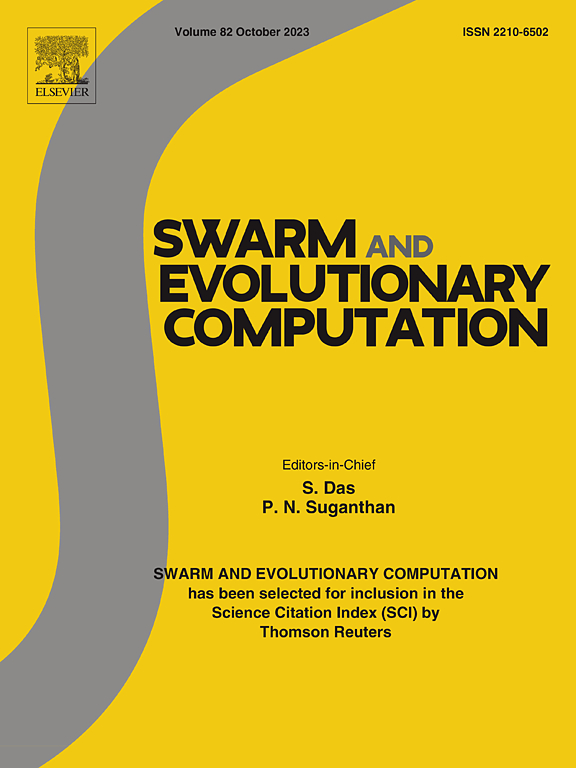一种非指数混合资产组合优化方法
IF 8.5
1区 计算机科学
Q1 COMPUTER SCIENCE, ARTIFICIAL INTELLIGENCE
引用次数: 0
摘要
随着金融业从分业经营向混业经营的转变,混合资产组合在投资组合中逐渐占有一席之地。现有的混合资产组合优化方法经常引入指数来表示资产类别,以消除资产类别之间的异质性。然而,引入的指标很少能全面、真实地反映资产类别,导致缺乏可行的解决方案和实际的可靠性。为了解决这些局限性,本文提出了一种由问题建模和问题求解组成的非指数混合资产组合优化方法。对于问题建模,我们的方法将混合资产组合优化建模为一个多目标双层次优化问题。在内部优化中,构建每个资产类别内的最优投资组合来表示相应的资产类别。这些最优投资组合包含了更多的信息,并由现实可用的产品构建而成,从而更全面、更实际地代表了资产类别。在外部优化中,对资产类别之间的配置进行优化,以获得最优的混合资产组合。在求解问题方面,提出了一种多群动态协同优化方法来求解模型问题。考虑到获得模型问题的完整内部优化具有挑战性和耗时,设计了动态协作机制,以获得内部优化的最优子集,从而高效地解决了问题。为了验证我们提出的非索引方法的有效性,进行了一项实验,将我们提出的方法与四种最先进的方法进行比较。我们提出的非指数方法问题在帕累托最优性和现实性能方面的30个场景中有27个优于竞争对手。本文章由计算机程序翻译,如有差异,请以英文原文为准。
A non-index mixed-asset portfolio optimization approach
As the financial industry shifts from divided operations to mixed operations, mixed-asset portfolios have gradually gained ground in investment portfolios. Existing mixed-asset portfolio optimization approaches frequently introduce indices for representing asset classes to eliminate heterogeneity among asset classes. However, few introduced indices comprehensively and realistically represent asset classes, leading to a loss of feasible solutions and practical reliability. To address these limitations, this paper proposes a non-index mixed-asset portfolio optimization approach consisting of problem modeling and problem solving. For problem modeling, our approach models the mixed-asset portfolio optimization as a multi-objective bi-level optimization problem. In the inner-level optimization, optimal portfolios within each asset class are constructed to represent the corresponding asset class. These optimal portfolios contain more information and are constructed from realistically available products, thus representing the asset class more comprehensively and practically. In the outer-level optimization, the allocation among the asset classes is optimized to obtain an optimal mixed-asset portfolio. For problem solving, a multi-swarm dynamic cooperative optimization method is proposed to solve the modeled problem. Considering that obtaining the complete inner-level optimization of the modeled problem is challenging and time-consuming, a dynamic collaboration mechanism is designed to obtain the optimal subset of the inner-level optimization, thus solving the problem efficiently and effectively. To verify the effectiveness of our proposed non-index approach, an experiment is conducted to compare our proposed approach with four state-of-the-art approaches. Our proposed non-index approach problem outperforms competitors in 27 of 30 scenarios on both the Pareto optimality and the realistic performance.
求助全文
通过发布文献求助,成功后即可免费获取论文全文。
去求助
来源期刊

Swarm and Evolutionary Computation
COMPUTER SCIENCE, ARTIFICIAL INTELLIGENCEC-COMPUTER SCIENCE, THEORY & METHODS
CiteScore
16.00
自引率
12.00%
发文量
169
期刊介绍:
Swarm and Evolutionary Computation is a pioneering peer-reviewed journal focused on the latest research and advancements in nature-inspired intelligent computation using swarm and evolutionary algorithms. It covers theoretical, experimental, and practical aspects of these paradigms and their hybrids, promoting interdisciplinary research. The journal prioritizes the publication of high-quality, original articles that push the boundaries of evolutionary computation and swarm intelligence. Additionally, it welcomes survey papers on current topics and novel applications. Topics of interest include but are not limited to: Genetic Algorithms, and Genetic Programming, Evolution Strategies, and Evolutionary Programming, Differential Evolution, Artificial Immune Systems, Particle Swarms, Ant Colony, Bacterial Foraging, Artificial Bees, Fireflies Algorithm, Harmony Search, Artificial Life, Digital Organisms, Estimation of Distribution Algorithms, Stochastic Diffusion Search, Quantum Computing, Nano Computing, Membrane Computing, Human-centric Computing, Hybridization of Algorithms, Memetic Computing, Autonomic Computing, Self-organizing systems, Combinatorial, Discrete, Binary, Constrained, Multi-objective, Multi-modal, Dynamic, and Large-scale Optimization.
 求助内容:
求助内容: 应助结果提醒方式:
应助结果提醒方式:


